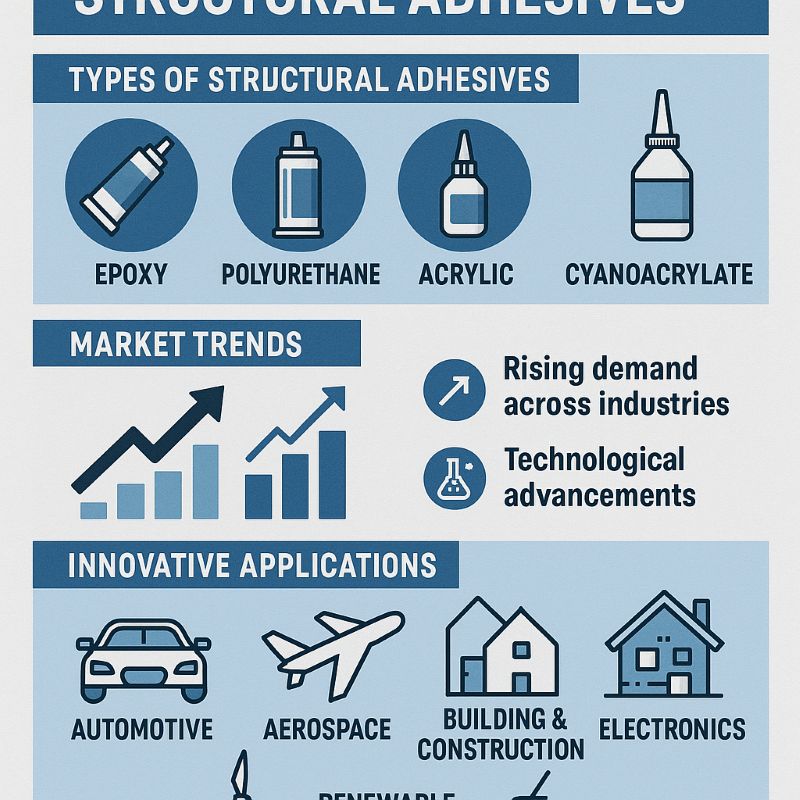
Defining Structural Adhesives
Types of Structural Adhesives
Importance in Global Markets
Key Growth Drivers
Innovative Application Methods
Latest Trends in Adhesives
Strategies for Market Expansion
Frequently Asked Questions (FAQ)
Structural adhesives are specialized bonding agents used in load-bearing applications where strength and reliability are critical. They are widely applied in industries such as automotive, aerospace, and construction. Growth in this market is being driven by rising demand for lightweight materials, enhanced durability, and environmentally responsible solutions. Sustainability trends and the development of eco-friendly adhesives are further shaping the future of this dynamic field.
Several types of structural adhesives are used to meet diverse industrial requirements:
Epoxy adhesives: provide high-strength and durable bonds, making them essential in automotive and aerospace applications.
Acrylic adhesives: deliver fast bonding, suitable for high-speed assembly lines.
Polyurethane adhesives: valued for flexibility and impact resistance.
Cyanoacrylate adhesives: cure rapidly and are favored in electronics and precision work.
These adhesive categories illustrate the versatility of structural bonding solutions in supporting lightweight design, efficiency, and sustainability.
Structural adhesives are integral to the competitiveness of global industries. They enable the use of advanced materials that reduce weight while maintaining durability—critical for sectors like automotive, aerospace, and construction. Their ability to replace traditional fasteners supports innovation in product design, efficiency in manufacturing, and alignment with global sustainability goals.
The global structural adhesives market is expanding rapidly due to:
Lightweight material adoption: especially in automotive and aerospace, where reducing weight improves performance and fuel efficiency.
Sustainability trends: development of eco-friendly and low-VOC adhesives to meet regulatory and consumer demands.
Construction sector growth: rising infrastructure investment increases demand for reliable bonding solutions.
Together, these drivers are shaping a market that emphasizes strength, efficiency, and ecological responsibility.
Modern application methods are revolutionizing the use of structural adhesives:
Automated dispensing systems improve speed and consistency.
Robotic application enhances accuracy and reduces waste.
Advanced spreading techniques ensure optimal bonding in precision-driven sectors such as aerospace and electronics.
These innovations not only improve efficiency but also support sustainability by minimizing material waste.
The structural adhesives market is evolving with several notable trends:
Eco-friendly formulations: growing focus on adhesives that reduce environmental impact.
Smart technologies: integration of sensors and monitoring systems into adhesive processes for real-time quality control.
Customization: tailored formulations designed for specific materials and applications.
These trends highlight the industry’s shift toward balancing performance with sustainability.
Companies aiming to expand in the structural adhesives market should consider:
Innovation: continuous R&D to improve strength, durability, and environmental performance.
Sustainability: aligning with stricter global regulations through eco-conscious formulations.
Customization: developing specialized adhesives for emerging materials and applications.
Strategic partnerships: collaborating across supply chains to expand global reach.
Distribution networks: strengthening logistics and market access to meet growing international demand.
What are structural adhesives?
They are specialized adhesives designed for load-bearing applications, ensuring high strength and reliability in industries like automotive, aerospace, and construction.
What types are available?
Epoxy, acrylic, polyurethane, and cyanoacrylate adhesives, each offering distinct properties such as durability, flexibility, or rapid curing.
Why are structural adhesives important globally?
They enable lighter, stronger materials and help industries improve efficiency, innovation, and sustainability.
What are the key growth drivers?
Lightweight material demand, eco-friendly product development, and expansion of the construction sector.
How are application methods evolving?
Through automated dispensing, robotics, and advanced spreading techniques that enhance precision and reduce waste.
What are the latest trends?
Sustainability, smart technology integration, and customized formulations tailored to specific needs.
How can companies expand in this market?
By focusing on R&D, sustainability, customization, strategic partnerships, and stronger distribution networks.
How do these adhesives benefit industries?
They improve product performance, manufacturing efficiency, and environmental compliance, while supporting long-term innovation.